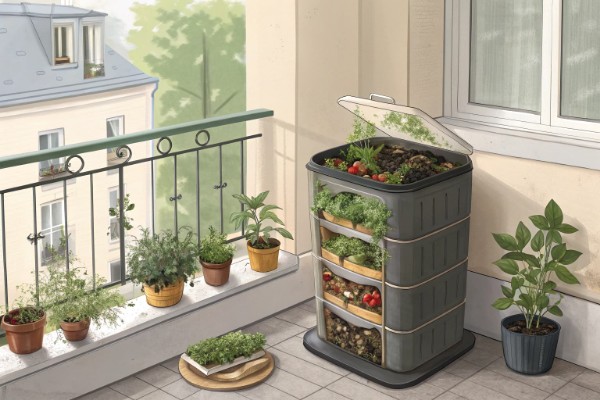Aeroponics: Growing Sustainable Gardens in the Modern Age

Aeroponics
Aeroponics grows edibles faster, healthier, and uses 95% less water than traditional methods. With nutrient-rich mist nourishing roots suspended in air, aeroponics sheds soil's weight and limits, letting gardeners produce thriving plants even in tight urban spots. Curious how aeroponics stacks up as the sustainable gardening solution we've long hoped for? Let's take a closer look.
Cheatsheet: Aeroponics at Home & Urban Spaces
🌱 Basics & Benefits
- 90% less water vs. soil methods
- Up to 3x faster crop cycles
- Rich nutrients = improved flavor & nutrient density
- Zero weed pressure, minimal pests
- Grow vertically in small indoor or outdoor spaces
- Boost food security & self-reliance
🛠️ Tools and Products You'll Need
- Aeroponic tower or DIY chamber
- Water pump (submersible)
- Nutrient reservoir
- Fine mist sprayers
- Net pots & plant collars
- Hydroponic nutrients
- pH meter, TDS meter
- Timer (for misting cycles)
- LED grow lights (if indoors)
- Fans (optional but helps air flow)
🧑🔬 Quick-Start Steps
- Assemble system: Connect chamber, pump, sprayers, timer, reservoir. Place in area with temp 65–80°F / 18–27°C.
- Mix nutrients: Use hydroponic solution. Adjust pH to 5.5–6.5.
- Insert plants: Place seedlings/clones in net pots with collars.
- Set mist cycle: 3–5 min ON, 10–15 min OFF (adjust for roots & humidity).
- Monitor: Weekly—check roots, clean sprayers, refill & balance reservoir.
- Harvest: Pick greens as soon as mature—usually 20–30 days after rooting.
🌡️ Precision Tips
- Keep solution at 65–72°F / 18–22°C (prevents root rot)
- Relative humidity: 50–70%
- Opt for filtered or RO water
- Flush system between crop cycles
🥬 Top Crops for Aeroponics
- Leafy greens: lettuce, spinach, arugula
- Herbs: basil, mint, cilantro
- Strawberries, tomatoes, peppers (use larger units)
What Exactly is Aeroponics?
First time I heard "aeroponics," I scoffed and thought someone was pulling my leg. Plants dangling mid-air with roots misted in nutrients—sounded like garden sorcery.
Turns out, aeroponics is real, and impressively effective. Picture plants growing without soil or water pools, their roots free-hanging, absorbing nutrients sprayed as fine mist.
How Aeroponics Actually Works
Years back, visiting an aeroponics setup, I watched roots suspended in enclosed trays, gently sprayed with nutrient-rich mist every few minutes. Roots absorb precisely what they need—water, nutrients, oxygen—nothing more, nothing less.
It's a controlled, clean, and precise plant-care method. No excess water, no wasted nutrients—just efficient growth.
The Equipment You Need
- A closed growing chamber, usually opaque, to keep roots in darkness.
- A nutrient misting system—pressurized pumps and fine mist nozzles.
- Lighting (LED grow lights usually)—plants still love sunshine, even simulated.
- A timer—automating nutrient misting at precise intervals.
Pretty straightforward, and surprisingly satisfying to assemble.
Real Benefits I've Seen From Aeroponics Gardening
I've tried soil gardening, hydroponics, and aquaponics. But the aeroponics setup blew my mind.
- Rapid growth rates: Plants grew roughly 30-50% faster compared to traditional gardening.
- Reduced water usage: Uses up to 95% less water than regular gardening.
- Less disease: Roots exposed to air reduce fungal and bacterial issues, eliminating the need for heavy pesticides.
- Space efficiency: Vertical stacking increases yield per square foot significantly.
Aeroponics systems are compact, clean, and highly productive. Perfect for urban gardens or limited spaces.
"NASA studies showed aeroponic systems can produce three times more crops than traditional soil systems, using significantly less water."
What Can You Grow With Aeroponics?
I experimented with everything from leafy greens and herbs to tomatoes and strawberries. Lettuce and basil grew faster than I could harvest them.
Even root vegetables—like potatoes and carrots—thrive, though root crops demand deeper chambers. Fruit-bearing plants require more nutrients but reward you generously once dialed in.
Challenges I Faced—And How I Overcame Them
I'll admit, aeroponics isn't entirely carefree. Power outages or equipment malfunctions can quickly stress your delicate plant roots.
Keeping spare pumps handy, choosing reliable timers, and checking nozzles regularly reduce risks dramatically. A backup power source or manual spray bottle can save the day—trust me.
Another tip: Nutrient solutions need regular monitoring. At first, it feels like chemistry homework, but soon it becomes second nature.
Why Aeroponics Might Be the Future of Gardening
Sustainable agriculture demands thoughtful resource use. Aeroponics aligns beautifully with sustainability principles—efficient water use, low inputs, minimal waste.
Personally, I appreciate knowing exactly what's touching my veggies—no pesticides, minimal fertilizers, just clean nutrients and air.
Watching plants thrive in mid-air feels futuristic yet wonderfully natural. It reminds me of Terence McKenna's musings—nature evolving alongside human ingenuity at accelerated rates.
"Aeroponics reconnects us, paradoxically, through technology, right back to the simple act of growing our own food."
Is Aeroponics Worth Trying at Home?
Absolutely. Early adopters might find a learning curve, but the rewards—fresh crops, minimal environmental impact, rapid growth—make it deeply fulfilling.
Start small with simple leafy plants, fine-tune your approach, then scale up. Soon, you'll happily find yourself explaining to neighbors how your plants float effortlessly mid-air, roots misted with nutrients—like magic, only better.

Want smarter plant choices? 🪴
Frequently Asked Questions about Aeroponics
What plants thrive best in aeroponic systems?
Many plant varieties thrive within an aeroponic environment, especially leafy greens such as lettuce, spinach, kale, and herbs like basil, mint, and cilantro. Additionally, strawberries, tomatoes, peppers, and certain root vegetables like potatoes grow efficiently using aeroponics, offering rapid growth cycles and superior yields.
How often should nutrient mists be applied in aeroponics?
Optimal misting intervals depend upon the plant species and environmental conditions. Typically, misting cycles of approximately 5 seconds every 3–5 minutes provide sufficient hydration and nutrient supply. Monitoring plant response and adjusting mist frequency accordingly ensures healthy root growth and plant development.
What type of nutrients do aeroponic systems require?
Aeroponic systems depend upon water-soluble nutrient solutions containing essential elements such as nitrogen, phosphorus, potassium, calcium, magnesium, and micronutrients. Selecting well-balanced, carefully monitored nutrients promotes vigorous root and plant growth and prevents deficiencies.
How do aeroponic systems prevent root diseases?
Aeroponic systems greatly reduce the risk of root diseases by suspending roots freely in air and limiting exposure to pathogens prevalent in soil-based systems. Periodic misting, proper sterilization, and adequate ventilation maintain sanitary conditions and promote robust root health.
Can aeroponics be used indoors or only outdoors?
Aeroponic setups function effectively both indoors and outdoors. Indoor aeroponic environments allow precise environmental controls like temperature (60–75°F / 16–24°C), humidity, and lighting, enabling year-round production. Outdoor systems benefit from natural sunlight but require monitoring of environmental fluctuations.
How much water is saved using aeroponic growing techniques?
Aeroponics drastically reduces water use compared to traditional farming methods. By delivering nutrients directly to plant roots via mist, aeroponic systems use approximately 90% less water, minimizing waste and significantly increasing sustainability.
How does aeroponics compare to hydroponics regarding plant growth?
Both aeroponics and hydroponics offer rapid plant growth and controlled conditions. However, aeroponics typically accelerates plant development due to increased oxygen availability at root zones, resulting in quicker maturation, larger yields, and healthier root systems compared to conventional hydroponics.
Is aeroponics suitable for commercial-scale agriculture?
Absolutely. Aeroponic technology scales effectively for commercial operations, offering high-density planting, faster crop turnover, reduced water consumption, and enhanced crop quality. Many commercial growers successfully implement aeroponics to meet market demands sustainably and efficiently.
Aeroponics strips things down to the roots—literally. You get faster growth, less water waste, and fewer pests. There’s a thrill in watching plants thrive on suspended mist, no soil needed. Sure, it asks for some attention and the right setup, but the payoff is fresh produce and a lighter footprint. Aeroponics is about growing smart—lean, clean, and efficient. If you’re ready to rethink how food can be grown, this method offers a clear path forward. For more ways to refine your approach, see the category page at taim.io/blog.
Aeroponics and Wellness: Nutritional Advantages of Soil-Free Gardening
Higher Nutrient Density
Studies report aeroponic crops have up to 30% increased nutrient content, including essential vitamins such as Vitamins C and E, compared to conventionally grown produce.
Enhanced Antioxidant Levels
Aeroponically cultivated leafy greens contain elevated antioxidant compounds like beta-carotene, helping reduce oxidative stress and support cellular health.
Cleaner Produce, Reduced Risks
- No soil interaction eliminates potential exposure to pathogens like E. coli and Salmonella.
- Minimal pesticide requirements lower chemical residues, promoting safer consumption for vulnerable populations.
Optimal Freshness and Taste
Immediate harvesting from aeroponic systems maintains crispness and preserves essential oils, resulting in noticeably fresher flavors and textures.
Support Self-Sufficient, Sustainable Eating
- Compact vertical designs require 90% less space, ideal for urban gardeners achieving dietary independence.
- Accelerated growth cycles (plant maturity 30%–50% faster) continually provide fresh crops, enhancing daily dietary variety.
Reduced Heavy Metals
Absence of soil-grown contamination significantly lessens heavy metal absorption—beneficial for kidney and liver health.
Find out which plants will thrive in your garden!
Answer a few fun questions and get custom plant recommendations perfect for your space. Let’s grow something amazing together!

start your season





